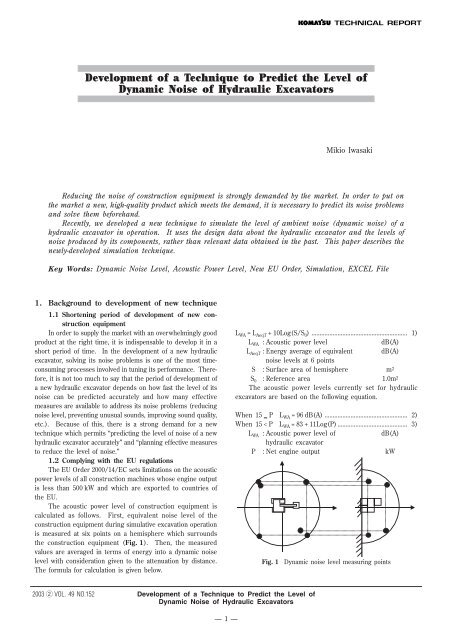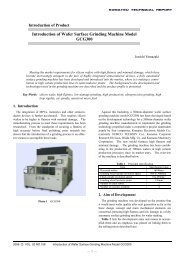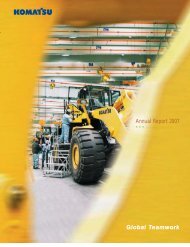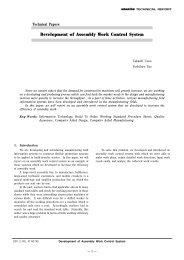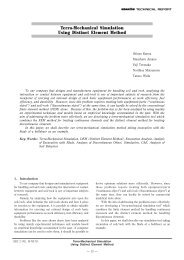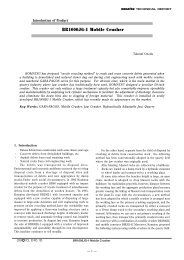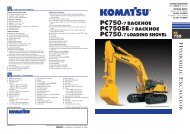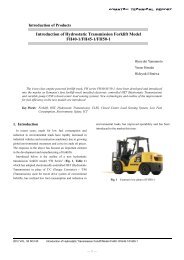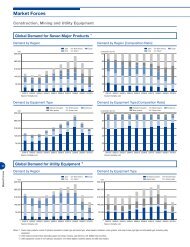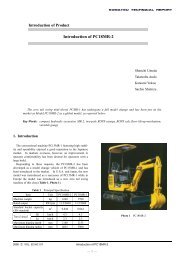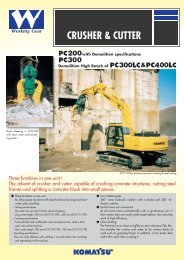Development of a Technique to Predict the Level of ... - Komatsu
Development of a Technique to Predict the Level of ... - Komatsu
Development of a Technique to Predict the Level of ... - Komatsu
You also want an ePaper? Increase the reach of your titles
YUMPU automatically turns print PDFs into web optimized ePapers that Google loves.
<strong>Development</strong> <strong>of</strong> a <strong>Technique</strong> <strong>to</strong> <strong>Predict</strong> <strong>the</strong> <strong>Level</strong> <strong>of</strong><br />
Dynamic Noise <strong>of</strong> Hydraulic Excava<strong>to</strong>rs<br />
Mikio Iwasaki<br />
Reducing <strong>the</strong> noise <strong>of</strong> construction equipment is strongly demanded by <strong>the</strong> market. In order <strong>to</strong> put on<br />
<strong>the</strong> market a new, high-quality product which meets <strong>the</strong> demand, it is necessary <strong>to</strong> predict its noise problems<br />
and solve <strong>the</strong>m beforehand.<br />
Recently, we developed a new technique <strong>to</strong> simulate <strong>the</strong> level <strong>of</strong> ambient noise (dynamic noise) <strong>of</strong> a<br />
hydraulic excava<strong>to</strong>r in operation. It uses <strong>the</strong> design data about <strong>the</strong> hydraulic excava<strong>to</strong>r and <strong>the</strong> levels <strong>of</strong><br />
noise produced by its components, ra<strong>the</strong>r than relevant data obtained in <strong>the</strong> past. This paper describes <strong>the</strong><br />
newly-developed simulation technique.<br />
Key Words: Dynamic Noise <strong>Level</strong>, Acoustic Power <strong>Level</strong>, New EU Order, Simulation, EXCEL File<br />
1. Background <strong>to</strong> development <strong>of</strong> new technique<br />
1.1 Shortening period <strong>of</strong> development <strong>of</strong> new construction<br />
equipment<br />
In order <strong>to</strong> supply <strong>the</strong> market with an overwhelmingly good<br />
product at <strong>the</strong> right time, it is indispensable <strong>to</strong> develop it in a<br />
short period <strong>of</strong> time. In <strong>the</strong> development <strong>of</strong> a new hydraulic<br />
excava<strong>to</strong>r, solving its noise problems is one <strong>of</strong> <strong>the</strong> most timeconsuming<br />
processes involved in tuning its performance. Therefore,<br />
it is not <strong>to</strong>o much <strong>to</strong> say that <strong>the</strong> period <strong>of</strong> development <strong>of</strong><br />
a new hydraulic excava<strong>to</strong>r depends on how fast <strong>the</strong> level <strong>of</strong> its<br />
noise can be predicted accurately and how many effective<br />
measures are available <strong>to</strong> address its noise problems (reducing<br />
noise level, preventing unusual sounds, improving sound quality,<br />
etc.). Because <strong>of</strong> this, <strong>the</strong>re is a strong demand for a new<br />
technique which permits “predicting <strong>the</strong> level <strong>of</strong> noise <strong>of</strong> a new<br />
hydraulic excava<strong>to</strong>r accurately” and “planning effective measures<br />
<strong>to</strong> reduce <strong>the</strong> level <strong>of</strong> noise.”<br />
1.2 Complying with <strong>the</strong> EU regulations<br />
The EU Order 2000/14/EC sets limitations on <strong>the</strong> acoustic<br />
power levels <strong>of</strong> all construction machines whose engine output<br />
is less than 500 kW and which are exported <strong>to</strong> countries <strong>of</strong><br />
<strong>the</strong> EU.<br />
The acoustic power level <strong>of</strong> construction equipment is<br />
calculated as follows. First, equivalent noise level <strong>of</strong> <strong>the</strong><br />
construction equipment during simulative excavation operation<br />
is measured at six points on a hemisphere which surrounds<br />
<strong>the</strong> construction equipment (Fig. 1). Then, <strong>the</strong> measured<br />
values are averaged in terms <strong>of</strong> energy in<strong>to</strong> a dynamic noise<br />
level with consideration given <strong>to</strong> <strong>the</strong> attenuation by distance.<br />
The formula for calculation is given below.<br />
L WA =L AeqT + 10Log(S/S 0 ) ........................................................... 1)<br />
L WA : Acoustic power level dB(A)<br />
L AeqT : Energy average <strong>of</strong> equivalent dB(A)<br />
noise levels at 6 points<br />
S : Surface area <strong>of</strong> hemisphere m 2<br />
S 0 : Reference area 1.0m 2<br />
The acoustic power levels currently set for hydraulic<br />
excava<strong>to</strong>rs are based on <strong>the</strong> following equation.<br />
When 15 P L WA = 96 dB(A) ................................................... 2)<br />
When 15 < P L WA = 83 + 11Log(P) ........................................... 3)<br />
L WA : Acoustic power level <strong>of</strong> dB(A)<br />
hydraulic excava<strong>to</strong>r<br />
P : Net engine output kW<br />
Fig. 1 Dynamic noise level measuring points<br />
2003 w VOL. 49 NO.152<br />
<strong>Development</strong> <strong>of</strong> a <strong>Technique</strong> <strong>to</strong> <strong>Predict</strong> <strong>the</strong> <strong>Level</strong> <strong>of</strong><br />
Dynamic Noise <strong>of</strong> Hydraulic Excava<strong>to</strong>rs<br />
— 1 —
The revised EU Order requires that <strong>the</strong> acoustic power level<br />
<strong>of</strong> every construction equipment sold in any <strong>of</strong> <strong>the</strong> countries <strong>of</strong><br />
<strong>the</strong> EU in and after January 2006 should be 3 dB(A) lower than<br />
<strong>the</strong> current regula<strong>to</strong>ry value.<br />
Looking at only <strong>the</strong> hydraulic excava<strong>to</strong>rs manufactured by<br />
<strong>Komatsu</strong>, more than 30 models, ranging in machine weight from<br />
0.3 <strong>to</strong>n <strong>to</strong> 110 <strong>to</strong>ns, are subject <strong>to</strong> <strong>the</strong> revised EU Order.<br />
Therefore, it is <strong>of</strong> urgent necessity for us <strong>to</strong> reduce <strong>the</strong>ir acoustic<br />
power levels. To reduce <strong>the</strong> acoustic power levels <strong>of</strong> so many<br />
models within <strong>the</strong> limited period <strong>of</strong> time, we must be able <strong>to</strong><br />
analyze <strong>the</strong>m speedily and easily. This calls for a new analytical<br />
system which can be used even in <strong>the</strong> field, unlike such analytical<br />
<strong>to</strong>ols as FEM and SYSNOISE.<br />
2. Conventional noise prediction method and its<br />
problems<br />
2.1 Conventional noise prediction method<br />
The calculation method that has been most commonly<br />
used <strong>to</strong> predict <strong>the</strong> dynamic noise level <strong>of</strong> a newly-developed<br />
hydraulic excava<strong>to</strong>r is this. From a bench test on <strong>the</strong><br />
contribution <strong>to</strong> noise <strong>of</strong> each <strong>of</strong> <strong>the</strong> components <strong>of</strong> an existing<br />
machine (q in Fig. 2), it is realized that <strong>the</strong> noise level <strong>of</strong> <strong>the</strong><br />
muffler (w in Fig. 2) can effectively be reduced. First,<br />
<strong>the</strong>refore, <strong>the</strong> amount <strong>of</strong> reduction in noise level <strong>of</strong> <strong>the</strong> muffler<br />
is deducted from <strong>the</strong> noise level <strong>of</strong> <strong>the</strong> newly-developed<br />
machine. Then, <strong>the</strong> noise levels <strong>of</strong> all <strong>the</strong> components are<br />
added up in terms <strong>of</strong> energy <strong>to</strong> predict <strong>the</strong> dynamic noise level<br />
<strong>of</strong> <strong>the</strong> newly-developed machine (e in Fig. 2).<br />
This method is also used in <strong>the</strong> study <strong>of</strong> measures <strong>to</strong><br />
reduce <strong>the</strong> dynamic noise level <strong>of</strong> a newly-developed machine.<br />
Namely, <strong>the</strong> effects <strong>of</strong> those measures are predicted based on<br />
<strong>the</strong> actual effects <strong>of</strong> measures taken with existing machines.<br />
q<br />
Noise level <strong>of</strong><br />
existing machine<br />
Muffler<br />
Engine<br />
w<br />
Noise level <strong>of</strong><br />
newly-developed machine<br />
Muffler<br />
Engine<br />
e<br />
2.2 Problems in conventional prediction technique<br />
(1) Necessity <strong>of</strong> studying contributions <strong>to</strong> noise <strong>of</strong> individual<br />
components <strong>of</strong> existing machine<br />
With <strong>the</strong> conventional prediction method, it is necessary<br />
<strong>to</strong> study <strong>the</strong> contribution <strong>to</strong> <strong>the</strong> dynamic noise level <strong>of</strong> each <strong>of</strong><br />
<strong>the</strong> components <strong>of</strong> an existing machine in order <strong>to</strong> predict <strong>the</strong><br />
dynamic noise level <strong>of</strong> a newly-developed machine.<br />
The contribution <strong>to</strong> dynamic noise level <strong>of</strong> each individual<br />
component is measured by extracting <strong>the</strong> dynamic noise level <strong>of</strong><br />
each component by: q installing a large muffler <strong>to</strong> reduce <strong>the</strong><br />
exhaust sound, w connecting a bellows pipe <strong>to</strong> keep <strong>the</strong> suction<br />
sound at a distance from <strong>the</strong> measuring point, e s<strong>to</strong>pping <strong>the</strong><br />
fan operation, r covering <strong>the</strong> engine with lead urethane, etc.<br />
The man-hours and cost involved in <strong>the</strong> study <strong>of</strong> contribution are<br />
a considerable burden on <strong>the</strong> development <strong>of</strong> a new machine.<br />
(2) Need for measurement data about existing machines<br />
<strong>Predict</strong>ing <strong>the</strong> dynamic noise level <strong>of</strong> a newly-developed<br />
machine requires not only results <strong>of</strong> studies <strong>of</strong> contributions<br />
<strong>to</strong> dynamic noise level <strong>of</strong> <strong>the</strong> individual components <strong>of</strong> existing<br />
machines but also <strong>the</strong> results <strong>of</strong> confirmation <strong>of</strong> <strong>the</strong> effects <strong>of</strong><br />
measures taken with existing machines and various o<strong>the</strong>r types<br />
<strong>of</strong> data, including <strong>the</strong> drawings <strong>of</strong> existing machines. Actually,<br />
however, <strong>the</strong> measurement data that are needed are almost<br />
nonexistent. In many cases, <strong>the</strong>refore, it is necessary <strong>to</strong> newly<br />
obtain measurement data with an existing machine or<br />
recalculate using substitute data.<br />
(3) Consideration for differences between new and existing<br />
machines<br />
A newly-developed machine differs from an existing<br />
machine in various respects – <strong>the</strong> outer panel thickness, engine<br />
speed, sound absorbing material application points, etc. Since<br />
<strong>the</strong> conventional method analyzes <strong>the</strong> dynamic noise level <strong>of</strong><br />
an existing machine based on its specific conditions, <strong>the</strong><br />
conditions <strong>of</strong> a newly-developed machine are not precisely<br />
reflected in <strong>the</strong> calculation.<br />
(4) Consideration for frequency range<br />
The conventional noise prediction method focuses on <strong>the</strong><br />
level <strong>of</strong> noise, leaving <strong>the</strong> frequency range <strong>of</strong> noise out <strong>of</strong><br />
consideration. With this method, <strong>the</strong>refore, it is difficult <strong>to</strong><br />
grasp <strong>the</strong> frequency range distribution <strong>of</strong> <strong>the</strong> sound source and<br />
determine effective sound absorbing materials and optimum<br />
outer panel thickness taking <strong>the</strong> frequency range in<strong>to</strong> account.<br />
Fan<br />
Fan<br />
Fig. 2 Conventional noise prediction method<br />
2003 w VOL. 49 NO.152<br />
<strong>Development</strong> <strong>of</strong> a <strong>Technique</strong> <strong>to</strong> <strong>Predict</strong> <strong>the</strong> <strong>Level</strong> <strong>of</strong><br />
Dynamic Noise <strong>of</strong> Hydraulic Excava<strong>to</strong>rs<br />
— 2 —
3. Introduction <strong>of</strong> new noise prediction method<br />
3.1 Features<br />
The new noise prediction method calculates <strong>the</strong> dynamic<br />
noise level <strong>of</strong> a hydraulic excava<strong>to</strong>r from bench test data about<br />
noise <strong>of</strong> its engine, muffler, and fan. It takes in<strong>to</strong> account <strong>the</strong><br />
transmission loss due <strong>to</strong> <strong>the</strong> engine hood, <strong>the</strong> absorption <strong>of</strong><br />
sound by <strong>the</strong> sound absorbing material, and <strong>the</strong> attenuation <strong>of</strong><br />
sound by distance. The salient features <strong>of</strong> <strong>the</strong> new method<br />
are as follows (Fig. 3).<br />
Design procedure<br />
3.2 Premises<br />
(1) The engine compartment is a diffuse sound field.<br />
(2) The open air is a semi-free sound field.<br />
(3) The main sound sources are <strong>the</strong> engine, muffler, and fan.<br />
(4) The new method cannot be applied when analysis results<br />
are influenced by <strong>the</strong> directivity <strong>of</strong> sound.<br />
(5) The engine compartment is assumed as an enclosure<br />
(soundpro<strong>of</strong> cover) (Fig. 4).<br />
Dynamic noise<br />
measuring point<br />
Measure <strong>to</strong> reduce noise<br />
Reducing<br />
opening area<br />
Setting aimed noise level<br />
Deciding engine compartment<br />
shape and specifications<br />
Engine compartment<br />
(enclosure)<br />
Engine<br />
Changing outer panel<br />
thickness, surface area,<br />
and material density<br />
NO<br />
Changing sound<br />
absorbing material,<br />
thickness, and<br />
application area<br />
NO<br />
NO<br />
Is sound absorbing<br />
capacity sufficient?<br />
YES<br />
Is amount <strong>of</strong> transmission<br />
loss sufficient?<br />
YES<br />
Calculating sound pressure<br />
<strong>of</strong> each sound source<br />
Calculating amount <strong>of</strong><br />
transmission loss<br />
Calculating sound<br />
absorbing capacity<br />
Calculating sound<br />
attenuation by distance<br />
Calculating dynamic noise level<br />
Is aimed noise<br />
level attained?<br />
END<br />
Fig. 3 Simulation flowchart<br />
YES<br />
(1) Data about existing hydraulic excava<strong>to</strong>rs are unnecessary.<br />
Since <strong>the</strong> new method uses <strong>the</strong> design data about a newlydeveloped<br />
hydraulic excava<strong>to</strong>r <strong>to</strong> simulate its noise, it does not<br />
require data about existing hydraulic excava<strong>to</strong>rs obtained in<br />
<strong>the</strong> past, such as <strong>the</strong>ir design data or <strong>the</strong> contribution <strong>to</strong> noise<br />
<strong>of</strong> each individual component.<br />
(2) Frequency range is taken in<strong>to</strong> consideration.<br />
Since <strong>the</strong> new method reflects even <strong>the</strong> frequency range<br />
<strong>of</strong> noise in <strong>the</strong> calculations, it permits analyzing <strong>the</strong> dynamic<br />
noise level in more detail.<br />
(3) Ease <strong>of</strong> use.<br />
Since <strong>the</strong> new method uses an EXCEL file for <strong>the</strong><br />
calculations, it is possible <strong>to</strong> easily grasp <strong>the</strong> dynamic noise<br />
level <strong>of</strong> a hydraulic excava<strong>to</strong>r or <strong>the</strong> effects <strong>of</strong> measures taken<br />
with <strong>the</strong> excava<strong>to</strong>r anywhere. All it needs is a personal<br />
computer.<br />
Fig. 4 Noise measuring point<br />
3.3 Principal data used analysis<br />
(All data about newly-developed hydraulic excava<strong>to</strong>r)<br />
(1) Data about covering <strong>of</strong> engine room compartment<br />
q Material w Thickness e Surface area<br />
r Material density t Opening area<br />
q Opening positions u External dimensions<br />
(2) Characteristics <strong>of</strong> sound absorbing material<br />
q Material w Thickness e Surface area<br />
r Absorption coefficient<br />
(3) Noise level around components<br />
q Engine sound w Muffler sound e Fan sound<br />
(Results <strong>of</strong> 1/3 octave band analysis in frequency range 20 Hz<br />
<strong>to</strong> 20 kHz)<br />
3.4 Main formulas used for calculations<br />
The simulation by <strong>the</strong> new method is based on <strong>the</strong><br />
combination <strong>the</strong> concepts <strong>of</strong> <strong>the</strong> following formulas for<br />
calculations and <strong>the</strong> analysis taking <strong>the</strong> frequency range in<strong>to</strong><br />
account (Fig. 5 and Fig. 6).<br />
Sound level, dB(A)<br />
L p TL<br />
Sound source Transmission loss<br />
sound pressure<br />
Engine compartment<br />
A<br />
Sound absorbing<br />
capacity Sound attenuation<br />
by distance<br />
Fig. 5 Simulation process<br />
L p<br />
L w<br />
TL<br />
A<br />
S<br />
Fig. 6 Simulation scheme<br />
L<br />
Calculated value<br />
r<br />
Measured value<br />
L<br />
2003 w VOL. 49 NO.152<br />
<strong>Development</strong> <strong>of</strong> a <strong>Technique</strong> <strong>to</strong> <strong>Predict</strong> <strong>the</strong> <strong>Level</strong> <strong>of</strong><br />
Dynamic Noise <strong>of</strong> Hydraulic Excava<strong>to</strong>rs<br />
— 3 —
(1) Outdoor noise <strong>of</strong> indoor sound source 1)<br />
With <strong>the</strong> engine compartment and open air assumed <strong>to</strong><br />
be indoor and outdoor, respectively, <strong>the</strong> concept <strong>of</strong> <strong>the</strong> following<br />
formula was reflected in <strong>the</strong> simulation. The fourth and fifth<br />
terms represent <strong>the</strong> sound attenuation by distance in a semifree<br />
sound field.<br />
The average absorption coefficient was obtained from<br />
relevant data supplied by <strong>the</strong> manufacturer <strong>of</strong> sound absorbing<br />
materials.<br />
L=L ρ – TL + 10Log(S/A) – 20Log(r) – 8 .................................. 4)<br />
TL = 10Log(ΣS n /(Στ n ·S n )) .......................................................... 5)<br />
A=α · S .......................................................................................... 6)<br />
L ρ : Sound pressure level <strong>of</strong> indoor sound source (dB)<br />
TL : Average transmission loss (dB)<br />
S : Total indoor surface area (m 2 )<br />
A : Indoor sound absorbing capacity (m 2 )<br />
r : Distance from wall surface <strong>to</strong> outdoor noise (m)<br />
measuring point<br />
α : Average indoor sound absorption coefficient<br />
S n : Partial area (m 2 )<br />
τ n : Partial transmittance<br />
(2) Effect <strong>of</strong> enclosure 2)<br />
Assuming <strong>the</strong> engine compartment as an enclosure<br />
(soundpro<strong>of</strong> cover), <strong>the</strong> concept <strong>of</strong> <strong>the</strong> following formula was<br />
adopted.<br />
The third term in Equation 7) represents <strong>the</strong> amount <strong>of</strong><br />
build-up (increase in sound pressure) due <strong>to</strong> <strong>the</strong> enclosure.<br />
L ρ =L W = 10Log(1/S + 4/R)<br />
=L W – 10Log(S) + 10Log[1 + 4(1 – α)/α] ............................ 7)<br />
R=αS/(1 – α) ............................................................................... 8)<br />
L ρ : Sound pressure level at wall surface (dB)<br />
inside enclosure<br />
Lw : Acoustic power level <strong>of</strong> sound source (dB)<br />
S : Total surface area <strong>of</strong> enclosure interior (m 2 )<br />
(same as <strong>to</strong>tal indoor surface area shown above)<br />
α : Average enclosure sound absorption coefficient<br />
(same as average indoor sound absorption<br />
coefficient shown above)<br />
R : Compartment constant <strong>of</strong> enclosure interior<br />
(3) Transmission loss 3)<br />
Transmission loss is <strong>the</strong> ratio <strong>of</strong> intensity Ii <strong>of</strong> sound<br />
reaching <strong>the</strong> wall surface <strong>to</strong> intensity It <strong>of</strong> sound penetrating<br />
through <strong>the</strong> wall, that is, 10Log (Ii/It). In practice, transmission<br />
loss is calculated by <strong>the</strong> following equation (Table 1).<br />
TL = 18Log(m · f) – 44 .................................................................. 9)<br />
m = n · t ........................................................................................... 10)<br />
m : Surface density (kg/m 2 )<br />
n : Material density (kg/m 3 )<br />
t : Wall thickness (mm)<br />
f : Sound frequency (Hz)<br />
Analyzed frequency range 20 Hz <strong>to</strong> 20 kHz<br />
Transmission loss<br />
Center<br />
frequency<br />
t<br />
S<br />
20<br />
8000<br />
10000<br />
12500<br />
16000<br />
20000<br />
APc<br />
fc<br />
TLC<br />
Table 1 Transmission loss calculation sheet<br />
Analysis <strong>of</strong> sound at entire surface<br />
<strong>of</strong> engine compartment<br />
dB (A)<br />
TL ’<br />
SPHC<br />
1.6<br />
—<br />
-0.8<br />
24.1<br />
47.8<br />
49.5<br />
51.5<br />
53.2<br />
57.6<br />
8028<br />
24.1<br />
3.2<br />
—<br />
4.6<br />
51.5<br />
53.2<br />
54.9<br />
56.9<br />
58.6<br />
63.2<br />
4014<br />
30.1<br />
τ ’<br />
SPHC<br />
1.6<br />
—<br />
1.2E+00<br />
3.9E–03<br />
1.7E–05<br />
1.1E–05<br />
7.2E–06<br />
4.8E–06<br />
3.2<br />
—<br />
3.5E–01<br />
7.2E–06<br />
4.8E–06<br />
3.2E–06<br />
2.1E–06<br />
1.4E–06<br />
SS400P<br />
3.2<br />
2.42<br />
8.3E–01<br />
1.7E–05<br />
1.2E–05<br />
7.7E–06<br />
5.0E–06<br />
3.3E–06<br />
Upper surface<br />
τ · Sn<br />
SPHC hole<br />
1.6 —<br />
3.88 2.59<br />
4.7E+00 2.6E+00<br />
1.5E–02<br />
6.5E–05<br />
4.3E–05<br />
2.8E–05<br />
1.9E–05<br />
2.6E+00<br />
2.6E+00<br />
2.6E+00<br />
2.6E+00<br />
2.6E+00<br />
TL<br />
Total.A<br />
—<br />
9.50<br />
0.7<br />
Transmission loss at coincidence frequency<br />
(4) Coincidence effect 2)<br />
The coincidence effect is <strong>the</strong> decline in transmission loss<br />
caused by a phenomenon similar <strong>to</strong> <strong>the</strong> resonance between<br />
<strong>the</strong> incoming sound and <strong>the</strong> wall surface. The frequency at<br />
which this phenomenon occurs is called <strong>the</strong> coincidence<br />
frequency. It is known that at <strong>the</strong> coincidence frequency, <strong>the</strong><br />
transmission loss is not as large as <strong>the</strong> law <strong>of</strong> mass indicates.<br />
f c =C 2 /(1.8 × 10 -3 ·CL · t) ............................................................. 11)<br />
f c : Coincidence frequency (Hz)<br />
C : Sound velocity (m/s)<br />
CL : Longitudinal wave propagation speed (m/s)<br />
(5.0 × 10 3 m/s for steel, 4.0 × 10 3 m/s for concrete)<br />
t : Wall thickness (mm)<br />
(5) Transmission loss at coincidence frequency 4)<br />
The transmission loss at <strong>the</strong> coincidence frequency was<br />
calculated by using <strong>the</strong> following equation <strong>to</strong> improve <strong>the</strong><br />
accuracy <strong>of</strong> simulation.<br />
TL c = 40 – 20Log (10/t) ................................................................ 12)<br />
TL c : Transmission loss at coincidence frequency (dB)<br />
t : Wall thickness (mm)<br />
4. Comparison with measured values<br />
4.1 <strong>Predict</strong>ion <strong>of</strong> dynamic noise level<br />
The dynamic noise level <strong>of</strong> each <strong>of</strong> five different hydraulic<br />
excava<strong>to</strong>rs was predicted by using <strong>the</strong> calculation method<br />
described above, and <strong>the</strong> calculated values were compared with<br />
<strong>the</strong> measured values. With <strong>the</strong> exception <strong>of</strong> one model which<br />
showed a difference <strong>of</strong> 2.2 dB (A), we could predict <strong>the</strong> dynamic<br />
noise level <strong>of</strong> each <strong>of</strong> <strong>the</strong> o<strong>the</strong>r four models within a difference<br />
<strong>of</strong> 1 dB (A). For model C, by predicting its dynamic noise level<br />
before completion, we could recognize <strong>the</strong> need for suitable<br />
measures <strong>to</strong> reduce <strong>the</strong> noise level and <strong>the</strong>reby shorten <strong>the</strong><br />
period <strong>of</strong> development (Fig. 7).<br />
20dB(A)/graduation<br />
Comparison between calculated<br />
and measured noise levels<br />
5.6<br />
5.6<br />
5.6<br />
5.6<br />
5.6<br />
Measured<br />
value<br />
Calculated<br />
value<br />
Sound source Sound absorbing Transmission Sound attenuation Noise level<br />
sound pressure capacity loss by distance<br />
Fig. 7 Comparison between calculated and measured noise<br />
levels<br />
2003 w VOL. 49 NO.152<br />
<strong>Development</strong> <strong>of</strong> a <strong>Technique</strong> <strong>to</strong> <strong>Predict</strong> <strong>the</strong> <strong>Level</strong> <strong>of</strong><br />
Dynamic Noise <strong>of</strong> Hydraulic Excava<strong>to</strong>rs<br />
— 4 —
4.2 <strong>Predict</strong>ion <strong>of</strong> effects <strong>of</strong> measures taken<br />
For model D, various measures <strong>to</strong> reduce its dynamic<br />
noise level were studied by using <strong>the</strong> new noise prediction<br />
method. As a result, we could judge <strong>the</strong> effects <strong>of</strong> those<br />
measures before <strong>the</strong>y were taken.<br />
(1) Planned measures <strong>to</strong> reduce dynamic noise level<br />
q Blocking some <strong>of</strong> <strong>the</strong> openings in <strong>the</strong> hood<br />
w Increasing <strong>the</strong> volume <strong>of</strong> sound absorbing material<br />
e Increasing <strong>the</strong> thickness <strong>of</strong> sound absorbing material<br />
r Lowering <strong>the</strong> engine speed<br />
(2) Result <strong>of</strong> confirmation<br />
An analysis by <strong>the</strong> new noise prediction method showed<br />
that planned measure q would be <strong>the</strong> most effective <strong>of</strong> <strong>the</strong><br />
four planned measures shown above. Therefore, we <strong>to</strong>ok that<br />
measure in order <strong>to</strong> confirm <strong>the</strong> accuracy <strong>of</strong> prediction.<br />
(1) Content <strong>of</strong> measure taken:<br />
Blocking some <strong>of</strong> <strong>the</strong> openings in <strong>the</strong> hood (The openings<br />
blocked are in <strong>the</strong> portion indicated by oblique lines in Fig. 8.)<br />
5. Implementation <strong>of</strong> experiment with model<br />
With <strong>the</strong> aim <strong>of</strong> fur<strong>the</strong>r improving <strong>the</strong> accuracy <strong>of</strong><br />
simulation by <strong>the</strong> new noise prediction method and isolating<br />
problems in <strong>the</strong> method, we carried out an experiment using<br />
a model in a semi-anechoic room <strong>of</strong> Shiga Prefectural University<br />
(Fig. 9 and Fig. 10).<br />
Fig. 9 Scene <strong>of</strong> experimentation with model (1)<br />
Fig. 8 Measure taken with <strong>the</strong> engine hood<br />
(2) Result <strong>of</strong> confirmation<br />
The predicted noise level was 72.2 dB (A) and <strong>the</strong> measured<br />
noise level was 71.9 dB (A). Thus, it was confirmed that <strong>the</strong> new<br />
noise prediction method could simulate even results <strong>of</strong> measures<br />
with a high degree <strong>of</strong> accuracy.<br />
Fig. 10 Scene <strong>of</strong> experimentation with model (2)<br />
5.1 Conditions<br />
Sound source : YAMAHA MS60S<br />
Specimen box : 0.7m × 0.8m × 0.4m, SPHC t1.6<br />
Semi-anechoic room : 5.0m × 5.0m × 3.0m(H)<br />
Noise produced : Pink noise Genera<strong>to</strong>r: RION SA28<br />
Noise meter : RION precision noise meter NA27<br />
Analyzer<br />
: ONO SOKKI DS9000 Series<br />
5.2 Method<br />
Assuming <strong>the</strong> speaker as <strong>the</strong> engine and <strong>the</strong> specimen box<br />
as <strong>the</strong> engine compartment, <strong>the</strong>ir dimensions were made <strong>the</strong><br />
same in proportion as a 15 <strong>to</strong>n class hydraulic excava<strong>to</strong>r. The<br />
noise level around <strong>the</strong> specimen box was obtained from <strong>the</strong> noise<br />
level around <strong>the</strong> speaker. With <strong>the</strong> specimen box placed at <strong>the</strong><br />
center <strong>of</strong> a virtual hemisphere in <strong>the</strong> test room, <strong>the</strong> dynamic<br />
noise level was measured by <strong>the</strong> method specified in ISO 3744<br />
(1994) (calculation <strong>of</strong> acoustic power level <strong>of</strong> sound source by<br />
sound pressure method) <strong>to</strong> check <strong>the</strong> validity <strong>of</strong> <strong>the</strong> new noise<br />
prediction technique. The main methods used are shown below.<br />
(1) Transmission loss<br />
Sound pressure level was measured inside and outside <strong>the</strong><br />
specimen box.<br />
(2) Sound absorbing capacity<br />
Sound pressure level inside <strong>the</strong> specimen box with and<br />
without <strong>the</strong> sound absorbing material (PET) was measured.<br />
2003 w VOL. 49 NO.152<br />
<strong>Development</strong> <strong>of</strong> a <strong>Technique</strong> <strong>to</strong> <strong>Predict</strong> <strong>the</strong> <strong>Level</strong> <strong>of</strong><br />
Dynamic Noise <strong>of</strong> Hydraulic Excava<strong>to</strong>rs<br />
— 5 —
5.3 Results<br />
In each calculation process, <strong>the</strong> difference between<br />
calculated and measured values, including those <strong>of</strong> noise level,<br />
was within 2 dB(A). It was found that <strong>the</strong> difference between<br />
calculated and measured values <strong>of</strong> transmission loss was <strong>the</strong><br />
largest. In <strong>the</strong> future, it is necessary <strong>to</strong> carry out many<br />
experiments and formulate an experimental formula so that <strong>the</strong><br />
new noise prediction technique can simulate <strong>the</strong> dynamic noise<br />
level more accurately (Fig. 11).<br />
Comparison between calculated and measured values<br />
dB(A)<br />
Measured<br />
value<br />
Calculated<br />
value<br />
Introduction <strong>of</strong> <strong>the</strong> writer<br />
Mikio Iwasaki<br />
Entered <strong>Komatsu</strong> in 1993. Currently<br />
working in Test Engineering Center,<br />
<strong>Development</strong> Division, <strong>Komatsu</strong>.<br />
[A few words from <strong>the</strong> writer]<br />
The advances in <strong>the</strong> field <strong>of</strong> CAE are so fast that almost<br />
everything can be predicted fairly accurately on <strong>the</strong> drawing board.<br />
However, truth lies only in principles, rules, workshops, actual<br />
things, realities. I think that this must be remembered when<br />
making simulations <strong>of</strong> any kind.<br />
Sound source Sound absorbing Transmission Sound attenuation Noise level<br />
sound pressure capacity loss by distance<br />
6. Conclusion<br />
Fig. 11 Results <strong>of</strong> experiment with model<br />
At present, <strong>the</strong> noise levels <strong>of</strong> almost all components <strong>of</strong><br />
construction equipment are evaluated by sound pressure levels<br />
measured at several points <strong>of</strong> each <strong>of</strong> those components. In <strong>the</strong><br />
future, we would like <strong>to</strong> improve <strong>the</strong> accuracy <strong>of</strong> calculation by<br />
<strong>the</strong> new noise prediction technique and shorten <strong>the</strong> period <strong>of</strong><br />
development <strong>of</strong> new hydraulic excava<strong>to</strong>rs by grasping <strong>the</strong> level<br />
<strong>of</strong> <strong>the</strong>ir noise in terms <strong>of</strong> <strong>the</strong> acoustic power level and reflecting<br />
<strong>the</strong> value in <strong>the</strong> simulation by <strong>the</strong> new technique. I wish <strong>to</strong><br />
express my heartfelt thanks <strong>to</strong> <strong>the</strong> people <strong>of</strong> Shiga Prefectural<br />
University for <strong>the</strong>ir generous cooperation in <strong>the</strong> verification<br />
experiment.<br />
References<br />
1) Antipollution Technology and Law (Noise Edition),<br />
Maruzen Co., Ltd., p. 133<br />
2) Kazuhiro Shiraki: Prevention <strong>of</strong> Noise and Simulation,<br />
Oyogijutsu Shuppan Co., Ltd., p. 229<br />
3) Acoustical Materials Association <strong>of</strong> Japan: Handbook on<br />
Measures against Noise and Vibration, Gihodo Shuppan<br />
Co., Ltd.<br />
4) WattersB.G., J.Acous.SocAm.31(7)898-911, 1959<br />
2003 w VOL. 49 NO.152<br />
<strong>Development</strong> <strong>of</strong> a <strong>Technique</strong> <strong>to</strong> <strong>Predict</strong> <strong>the</strong> <strong>Level</strong> <strong>of</strong><br />
Dynamic Noise <strong>of</strong> Hydraulic Excava<strong>to</strong>rs<br />
— 6 —


